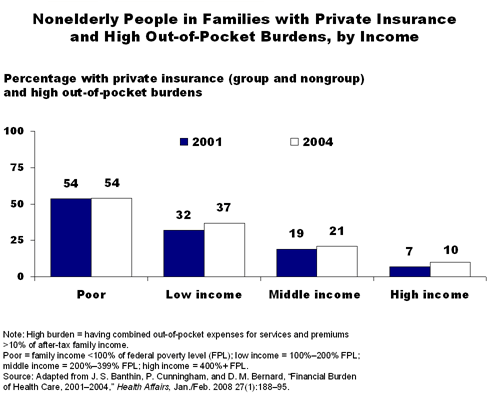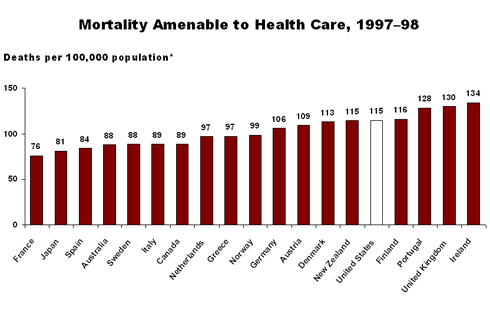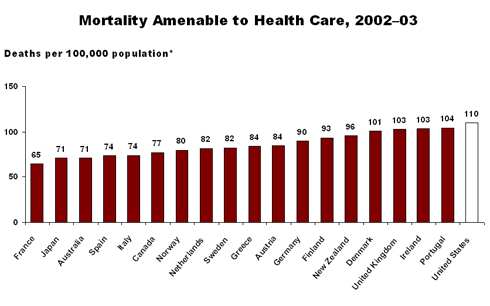By Ellen Nolte and C. Martin McKee
Health Affairs
January/February 2008
We compared trends in deaths considered amenable to health care before age seventy-five between 1997-98 and 2002-03 in the United States and in eighteen other industrialized countries. Such deaths account, on average, for 23 percent of total mortality under age seventy-five among males and 32 percent among females. The decline in amenable mortality in all countries averaged 16 percent over this period. The United States was an outlier, with a decline of only 4 percent. If the United States could reduce amenable mortality to the average rate achieved in the three top-performing countries, there would have been 101,000 fewer deaths per year by the end of the study period.
… although ranking fifteenth in 1997-98 and performing considerably better than Ireland, the United Kingdom, and Portugal, by 2002-03 the United States had the highest rate of amenable mortality, just above Ireland and the United Kingdom but far above countries such as France, Japan, and Australia.
The concept of amenable mortality captures the potential impact of health care on population health only; thus, assessment of overall health system performance also requires analyses of indicators that measure the relative success of policies outside the direct control of the health care sector that also affect the public’s health, such as tobacco and alcohol policies. Although such an analysis would enrich the picture painted here, it clearly goes beyond the scope of this paper. Even in the absence of such an analysis, it is important to highlight the comparatively slow U.S. progress in reducing mortality from IHD and other circulatory diseases, largely stroke. Further interpretation of these observations must remain speculative. It is, however, difficult to disregard the observation that the slow decline in U.S. amenable mortality has coincided with an increase in the uninsured population, an issue that is now receiving renewed attention in several states and among potential presidential candidates from both parties.
http://content.healthaffairs.org/cgi/content/full/27/1/58
Comment:
By Don McCanne, MD
Amenable mortality is defined in this study as “deaths from certain causes that should not occur in the presence of timely and effective health care.”
Those who still claim that the United States has the best health care system in the world need a reality check. Of the nineteen OECD nations studied, the United States has the highest rate of deaths that “should not occur in the presence of timely and effective health care.”
Further, in the time interval studied, the United States ranked last in the reduction of amenable mortality. The other eighteen nations were more effective in reducing these preventable premature deaths.
The opponents of reform will provide alternative explanations for these numbers, likely blaming a lack of personal responsibility (poor nutrition, smoking, lack of exercise, etc.). But what they will suppress is the fact that these are amenable death rates. Interventions through public health services and personal health care can prevent many of these deaths.
In the United States we are spending more than enough to accomplish these goals. The other eighteen nations have done so with far less health care spending, but with financing systems that are more efficient, more effective, and more equitable.
When the reform process is disrupted by those who wish to shift the topic to individual responsibility, we can agree that individuals should be encouraged to adhere to optimal health habits, and that we should use our abundant resources to help accomplish that. But we cannot digress from our advocacy for an efficient, effective, equitable financing system that is the essential first step toward providing timely, effective health care for everyone. One hundred thousand lives depend on it.


